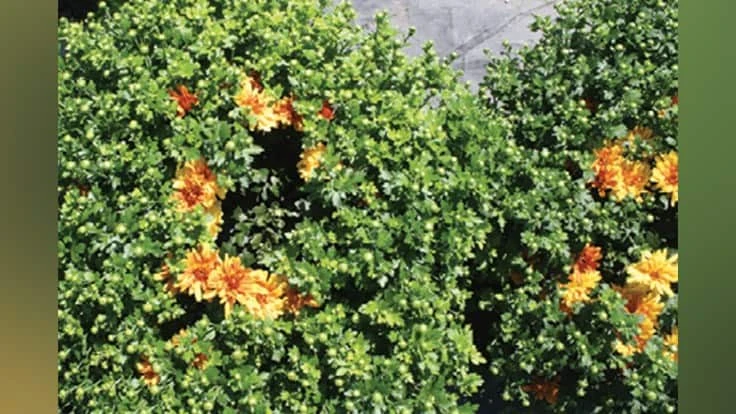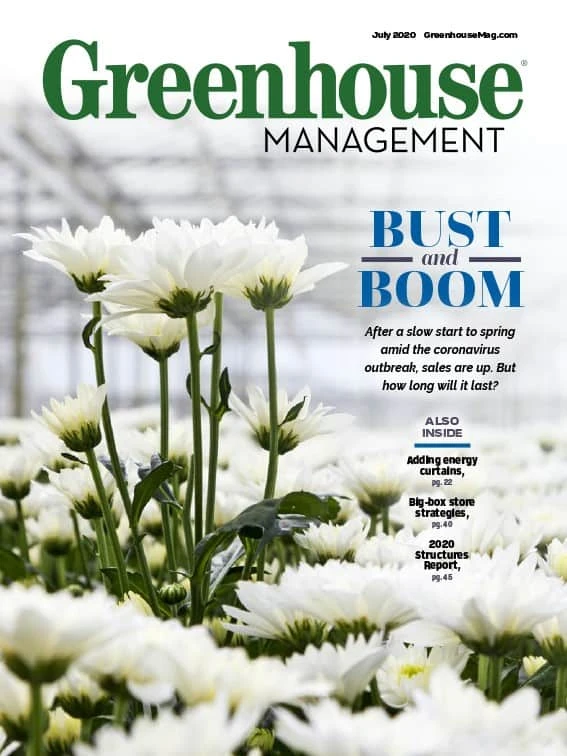

Garden mums are a popular floriculture crop, and they provide opportunity for summer production. It is common for garden mums to be grown outdoors, but since that environment can’t be controlled like the greenhouse, premature buds can form (Fig. 1), which can stop a crop from reaching its target height, resulting in unmarketable plants.
Causes of premature budding
Let’s review what controls flowering in chrysanthemums. Potted or florist chrysanthemum flowering is controlled by day length, induced by short days. However, garden mum flower induction can be influenced by both day length and temperature. Garden mums form flowers in response to short days, but temperature also influences flowers. Specifically, cool air temperatures (in the mid-60s or lower) can induce premature flowering in garden mums grown outdoors.
The effect of cool temperature on flowering poses challenges for producers growing their garden mums outdoors. Premature budding is most problematic for the earliest planted garden mums, such as large container sizes that require a longer production period, or for the earliest mum crops of the season. Whether it’s due to a large container size or an early sales date, the odds of experiencing cool night temperatures can move up the timeframe the crop is planted and placed outside. Cool temperatures can occur throughout the spring, and into June for northern growers.
Stress throughout the rest of the production cycle can also induce premature flower bud formation.
Temperature
The ability to mitigate temperature stress on garden mums varies widely depending on what environment the crop is grown in. As long as the target air temperature is correct and heating equipment is working properly, it is easy to avoid cold temperature stress in a controlled environment like a greenhouse. However, a large proportion of garden mums are grown outdoors, not in a greenhouse. There is little that can be done to protect mums from cold outdoor air temperatures. Short of building specialized structures for growing mums outdoors, think creatively about how you can use your existing space. If cold temperature-induce premature buds happen more often than not with your garden mum crops, see if there is any greenhouse space that may be available. Greenhouse space may be used to start the mums until the threat of cold temperatures has passed. Then they can be moved outside and finished. Alternatively, some garden mum crops are grown entirely in the greenhouse — not outdoors — mitigating risks of early-season cold stress.
Water and nutrition
Stressed garden mums are more prone to form premature buds, especially when exposed to cool temperatures. Keeping garden mums well-irrigated and -fertilized will help combat premature budding. Water and nutrition can be used to push growth that will cover the premature buds.
While growing on the dry side can help check growth and reduce disease pressure, it can also promote premature flower bud formation. Stressed plants can induce more easily than non-stressed plants. Therefore, keeping garden mums well-watered can help keep them vegetative. In addition to water, fertilizer can also help combat premature budding. Under-fed garden mums can be more prone to premature budding than plants that are well-fed. It is easier than you think to under-feed garden mums because they are heavy-feeding plants. Recommended nitrogen concentrations range from 250 to 300 ppm for constant liquid fertilization. One strategy that can be particularly useful for garden mums grown outdoors is to provide controlled-release fertilizer (CRF) at half the recommended rate, then combine with water-soluble fertilizer (WSF) at half the recommended rate. Additionally, since CRFs release more with warm temperatures, the unwanted spikes in EC from excessive nutrient release is avoided by using the half-rate of CRF.
These same recommendations for managing water and nutrition can be used even if premature buds form. By promoting vegetative growth through ample water and nutrition, vegetative growth can resume and grow over the premature buds. This will help “mask” the flowers and allow you to get your plants to their target finished size.
The basic control system for vents includes a sensor, environment control, contactor panel, vent controller and gearmotor that moves the vent arms.
Ethephon
Another useful tool to help avoid premature budding on garden mums is to apply ethephon, commonly available as Collate or Florel. These are ethylene-generating plant growth regulators, where the ethephon converts into ethylene after being applied to plants. One effect ethylene has on plants is that it, causes flower abortion prevents flower bud formation. So, by applying foliar sprays of ethephon to garden mums, premature buds are physiologically incapable of forming.
Ethephon applications can begin one-and-a-half to two weeks after cuttings are stuck for propagation. Applying up to 500 ppm ethephon work well for garden mums.. For pinched crops, wait a week or two after the pinch occurs. Be mindful of how much time is left to finish mums, as flowering can be delayed past the target flowering date if ethephon sprays continue too long. Adequate time needs to be allowed for plants to form flowers, and ethephon should not be applied with less than 6 to 8 weeks of production time left.
Take-home
Garden mums are an important crop for many growers, but growing outdoors presents challenges not experienced in conventional greenhouse environments. However, even though cool temperatures and stress pose the threat of inducing buds prematurely on mums, there are opportunities to modify the growing environment or culture to prevent premature flower formation.

Explore the July 2020 Issue
Check out more from this issue and find your next story to read.
Latest from Greenhouse Management
- 2025 Proven Winners Horticulture Scholarship applications now open
- How to improve inventory and shipping management in the greenhouse
- Leading Women of Horticulture: Anna Ball, Ball Hort, and Terri McEnaney, Bailey Nurseries
- GM CEA HERB Part 2: A guide to increasing the sowing density of culinary herbs
- GM CEA HERB Part 1: Best practices for producing culinary herbs in controlled environments
- USDA fires experts on invasive pests, including Asian citrus psyllid, chilli thrips
- CEA Alliance celebrates bipartisan introduction of Supporting Innovation in Agriculture Act
- Dümmen Orange North America celebrating 25th anniversary in 2025





